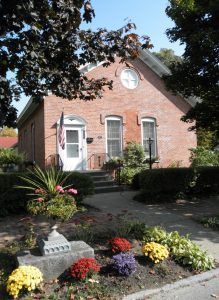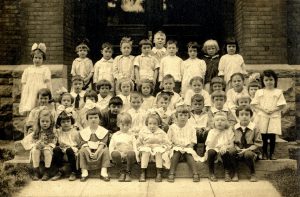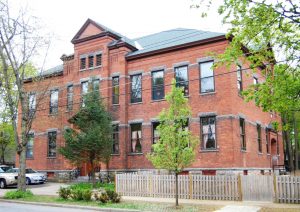Saratoga Springs Preservation Foundation
Preservation Matters – York Avenue School
Samantha Bosshart, Executive Director
October 2, 2013
School is Back in Session
School 7

Photo provided Former School 6 at 170 Clinton St. historically had two doors, one entrance for boys and one for girls.
Fall always marks the time of year when students go back to school. Many may not realize that Saratoga Springs has a long history of education and that while some historic school buildings have been lost over time, others still remain. Of the buildings that remain, only one still operates as a school – 62 York Avenue – the home of the Waldorf School.
By the mid-1870s, School 4 located on Spring Street was overcrowded and a new space was needed. A one-story brick building was constructed on York Avenue and named School 7. According to Early Saratoga Schooldays, a scandal was associated with the construction of this building. The first funds to erect School 7 came from the generosity of notorious gambler and president of the Saratoga Racing Association, John Morrissey. He gave the entire proceeds from one Saturday’s racing to fund the new school upon hearing of the crowded conditions. While the Board accepted his gift, it was a “closely guarded secret” for some time.
The first brick school building on York Avenue was a replica of the one-room school building, School 6, that still stands today at the corner of Clinton and Vermont streets. Now a residence, 170 Clinton Street was built to accommodate overcrowding of School 2, which also still stands today at the corner of Woodlawn Avenue and Van Dam Street (38 Van Dam Street).
School 7 on York Avenue housed primary grades and had an enrollment of 122 students. In the 1880’s a second story was added to accommodate more children. In 1891, as repairs were being discussed the walls of the school cracked diagonally so a new school was necessary. The building was constructed the following year at the cost of $17,000.
The brick building that stands today at 62 York Avenue was inspired by the Richardson Romanesque style, which was in vogue between 1870 and 1900. The style, popular for public buildings, was named after innovative Boston architect Henry Hobson Richardson who was responsible for the Trinity Church in Boston (1872), Sever Hall at Harvard University (1878), and Albany City Hall (1883). Typical of the style it was constructed of brick, featured a tower, and had a rusticated stonework foundation, rounded arched entrance, window lintels and sills, and belt courses.
In 1957, “twin” elementary schools – Caroline Street on the east side and Division Street on the west side – were built to replace the city’s five aging elementary schools, including 62 York Avenue, which were overcrowded with World War II baby boomers. The City of Saratoga Springs School District sold 62 York Avenue in 1964. Over the years it had four different owners and was listed in the City Directories of Saratoga Springs as vacant, but was used as a warehouse.

Photo courtesy of Saratoga Springs Public Library Shown here is School 7’s 1917 kindergarten class.
In 1981, sixteen preschoolers gathered for their first day of Waldorf education at Temple Sinai, under the leadership of Eva Nagel. The Waldorf philosophy of education was developed by Rudolph Steiner in Germany in 1919. It is a developmental approach to education that focuses on engaging the body, mind, and spirit through interdisciplinary and experiential learning. Each year the school enrollment increased and the curriculum expanded to different grades. As the Waldorf School expanded it rented space in various locations throughout Saratoga.
In 1986, a commitment was made to become a true Waldorf school. A Board of Directors was formed and the parents and faculty decided to establish a permanent home for the Spring Hill Waldorf School. According to a parent at the time, Mark Straus, his wife Betty noticed the old school building on York Avenue. “Despite the windows being boarded up, there were cars in the lot, so we knocked and entered the cavernous dark space with only a small light coming from the rear of the building. We found the owner playing cards with a couple of employees. I explained our need for a school building and asked politely if the building might be for sale. The owner said there was no way he could sell because he needed it for his business.”
Straus did the analysis and showed the owner, Raymond Lockwood, that the deal would provide him with enough money to cover the cost of building a warehouse on his farm property. However, there was one more hurdle before the deal could be finalized – how would it be financed. Straus toured Charles Wait of Adirondack Trust Company through the building. “You have no idea when we first looked at this loan what a mess this building was,” said Wait. With Wait’s support, 14 families co-signed the mortgage.
With “sweat equity” from parents and assistance from a member item from the New York State legislature the school was renovated and opened in 1987. Straus says, “In retrospect, this is one of the most important historic renovations I’ve been involved with,” which says a lot considering his rehabilitations of several historic buildings on Broadway.

Waldorf School located on 62 York Ave, 2013
The Waldorf School now has 250 students from kindergarten through high school in four buildings. Gina Michelin, a Waldorf parent since 2004, says “The children and families really endear themselves to the building, and I believe it is because of its structure, integrity and history. I love that my children have the opportunity to be in such a beautiful school building and be surrounded by beautiful old wood, tall windows, gentle school house lighting, and tin ceilings. Combined with the classical Waldorf touches – the colorful lazured walls, flowers, and smells of lavender, beeswax, and bread – it’s better than home!”
The next time you pass by the former school buildings mentioned – Clinton Street, Van Dam Street, and Spring Street – stop and imagine them with school children. Fortunately, thanks to the hard work of many, you don’t have to imagine the school children coming and going from 62 York Avenue as the building currently has the pitter-patter of children’s feet and their laughter in the halls.
Founded in 1977, the Saratoga Springs Preservation Foundation is a private, not-for-profit organization that promotes preservation and enhancement of the architectural, cultural and landscaped heritage of Saratoga Springs.
This article originally appeared in The Saratogian.
